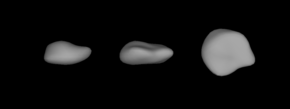 Lightcurve-base 3D-model of Hertha | |
| Discovery[1] | |
|---|---|
| Discovered by | C. H. F. Peters |
| Discovery site | Litchfield Obs. |
| Discovery date | 18 February 1874 |
| Designations | |
| (135) Hertha | |
| Pronunciation | /ˈhɜːrθə/ |
Named after | Nerthus[2] (Norse mythology) |
| A874 DA | |
| main-belt[1][3] · (inner) Nysa (Hertha)[4][5] | |
| Orbital characteristics[3] | |
| Epoch 23 March 2018 (JD 2458200.5) | |
| Uncertainty parameter 0 | |
| Observation arc | 133.34 yr (48,701 d) |
| Aphelion | 2.9320 AU |
| Perihelion | 1.9239 AU |
| 2.4279 AU | |
| Eccentricity | 0.2076 |
| 3.78 yr (1,382 d) | |
| 233.89° | |
| 0° 15m 37.8s / day | |
| Inclination | 2.3052° |
| 343.65° | |
| 340.16° | |
| Physical characteristics | |
| 76.12 ± 3.29 km[6] 79.24±2.0 km[3] | |
| Mass | (1.21 ± 0.16) × 1018 kg[6] |
Mean density | 5.23 ± 0.96 g/cm3[6] |
| 8.40061 h[7] | |
| 0.1436[3] | |
| M[8] | |
| 8.23[1][3] | |
135 Hertha is an asteroid from the inner region of the asteroid belt, approximately 77 kilometers (48 miles) in diameter. Discovered on 18 February 1874 by German–American astronomer Christian Peters at the Litchfield Observatory near Clinton, New York,[1] it was named after the Teutonic and Scandinavian goddess of fertility, Hertha, also known as Nerthus.[2] It orbits among the Nysa asteroid family, but its classification as a metallic M-type asteroid does not match the more common F-type asteroid for this family, suggesting that it may be an interloper.[9] Spectroscopic analysis indicates the possible presence of hydrated silicates indicating that Hertha should possibly be reclassified from its present M-type to the proposed W-type.[10]
Lightcurve data from Hertha indicates a flattened body,[7] and radar observations indicate that Hertha is non-metallic.[11] Five occultations of stars by the asteroid have been observed between 2000 and 2015.
- ^ a b c d Cite error: The named reference
MPC-objectwas invoked but never defined (see the help page). - ^ a b Cite error: The named reference
springerwas invoked but never defined (see the help page). - ^ a b c d e Cite error: The named reference
jpldatawas invoked but never defined (see the help page). - ^ Cite error: The named reference
Ferretwas invoked but never defined (see the help page). - ^ Cite error: The named reference
AstDys-objectwas invoked but never defined (see the help page). - ^ a b c Cite error: The named reference
Carry2012was invoked but never defined (see the help page). - ^ a b Torppa, J.; et al. (August 2003). "Shapes and rotational properties of thirty asteroids from photometric data". Icarus. 164 (2): 346–383. Bibcode:2003Icar..164..346T. doi:10.1016/S0019-1035(03)00146-5.
- ^ Dotto, E.; et al. (October 1992). "M-type Asteroids: Rotational properties of 16 Objects". Astronomy and Astrophysics Supplement Series. 95 (2): 195–211. Bibcode:1992A&AS...95..195D.
- ^ Cellino, A.; Vincenzo, Z. (October 1993). "Asteroid 'clans': Super-families or multiple events?". Celestial Mechanics and Dynamical Astronomy. 57 (1–2): 34–37. Bibcode:1993CeMDA..57...37C. doi:10.1007/BF00692459.
- ^ Cellino, A.; et al. (August 2001). "The Puzzling Case of the Nysa–Polana Family". Icarus. 152 (2): 225–237. Bibcode:2001Icar..152..225C. doi:10.1006/icar.2001.6634.
- ^ Shepard, M.K.; et al. (September 2006). "More Results from a Long-Term Radar Survey of M-Class Asteroids". Bulletin of the American Astronomical Society. 38: 626. Bibcode:2006DPS....38.7101S.